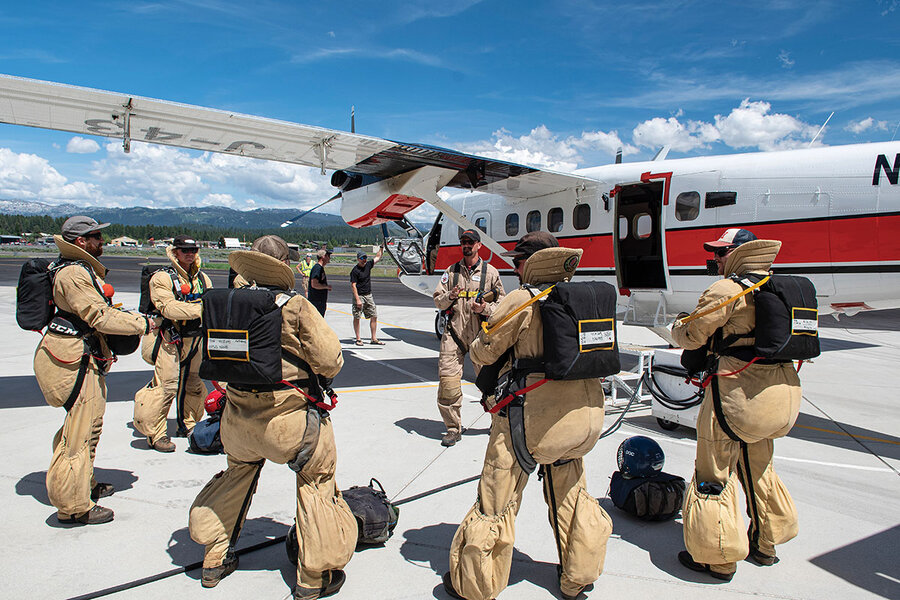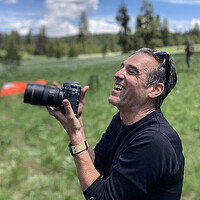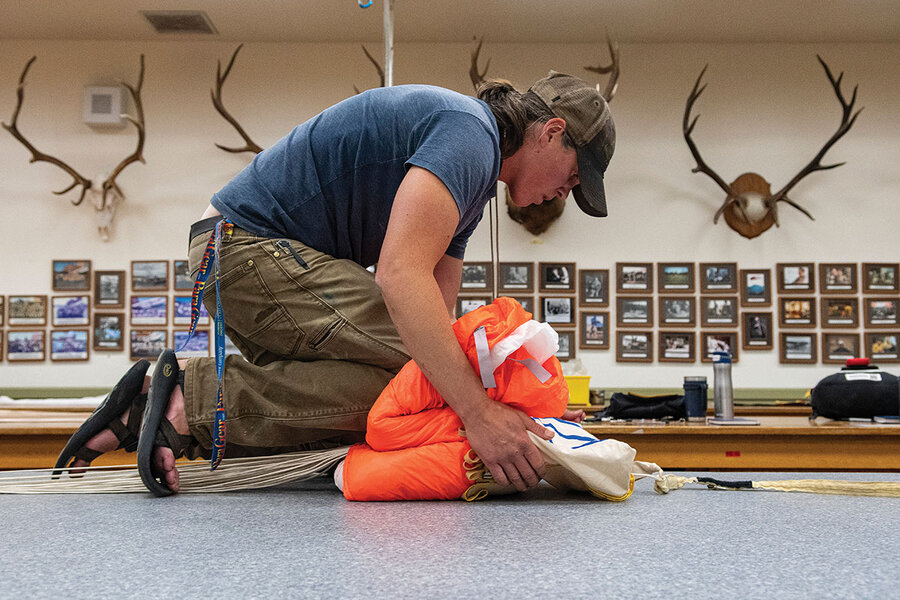In Pictures: The smokejumpers of McCall, Idaho
Loading...
| McCall, Idaho
Smokejumpers are a special breed of firefighter. In addition to being physically fit, they must learn how to read the weather and jump safely out of planes into scorching wildfires.
On a recent morning at McCall Smokejumper Base in Idaho, the team gathers for the daily weather report. This is not your typical TV news fare. With charts and graphs, the report goes in-depth on wind speed, humidity, pressure, conditions on the ground, and an array of other data.
Why We Wrote This
A story focused onIt takes courage, training, and teamwork to make it as a smokejumper. Rookies become adept at reading the weather, rigging gear, and landing softly.
Then the smokejumpers pile into two planes to practice their skills parachuting into a meadow. Each team has a spotter who determines the release point from the plane. Later, when the crews are back on the ground, the jumps will be rated for accuracy and, more importantly, soft landings. No fire jumper wants to be injured on the drop into a conflagration.
Smokejumpers have to be ready at a moment’s notice for dangerous assignments in far-flung locations. For newbies, the training is rigorous and taxing.
When asked why rookies are pushed so hard, operations foreman Brent Sawyer smiles and says, “We just want to make sure they want to be here.”
As a new morning starts, the McCall Smokejumper Base in Idaho is already in full swing. Rookies are being put through the wringer, doing pushups and pullups to the tune of trainers shouting, “What do you want to be?” When I ask operations foreman Brent Sawyer why rookies are pushed so hard, he smiles and says, “We just want to make sure they want to be here.”
At the same time, the operations desk gathers the rest of the smokejumpers for the morning weather report. This is not your typical TV news fare. With charts and graphs, the report goes in-depth on wind speed, humidity, pressure, conditions on the ground, and an array of other data that I can’t follow. As the smokejumpers listen, I almost see a spark of hope in their eyes for the opportunity to jump a fire. If I were to describe the typical smokejumper, I would say he or she is a combination of a special ops soldier, a tailor, and a ski bum.
This morning, smokejumpers pile into two planes to practice their skills by jumping into the meadow below, where the landing spot is marked with a small flag. Each team has a spotter who determines the release point from the plane. Later, when the crews are back on the ground, the jumps will be rated for accuracy and, more importantly, soft landings. No fire jumper wants to be injured on the drop into a conflagration.
Back at the base, there is no idle moment. All the parachutes that have been deployed must be meticulously inspected for rips and defects, and every single line must be checked individually. From this point, the chute goes either to the repair shop or to be rigged. The art of rigging, which demands full-body action and intricate folding, is a combination of sumo wrestling and origami-making. This goes on for hours.
At the end of a long day, the sun starts to hide behind the snowcapped mountains.
I drive off the base and see a small group of runners on the side of the road. One of them sings out, “What do you want to be?” and the rest reply, “Smokejumpers!”













